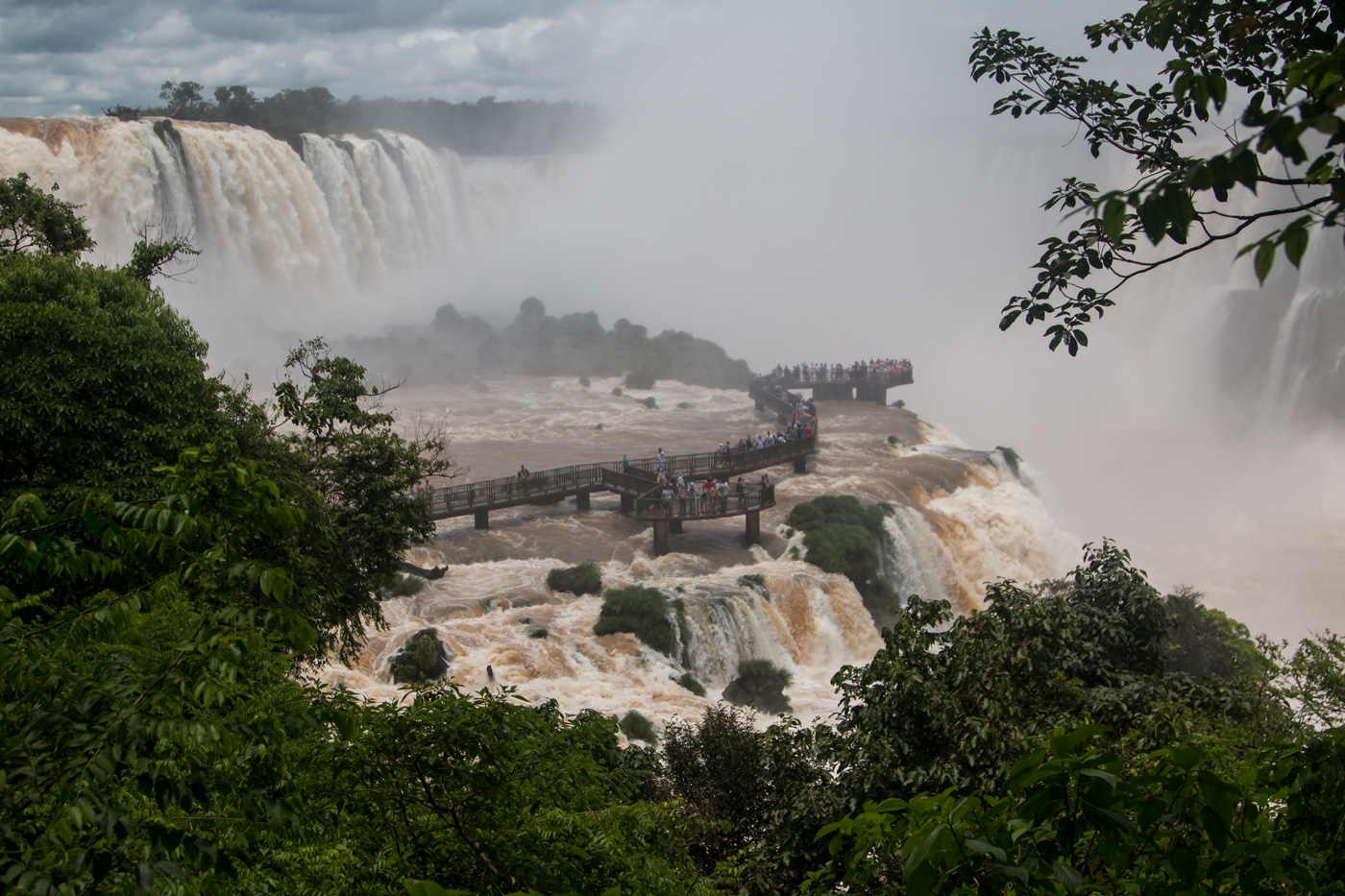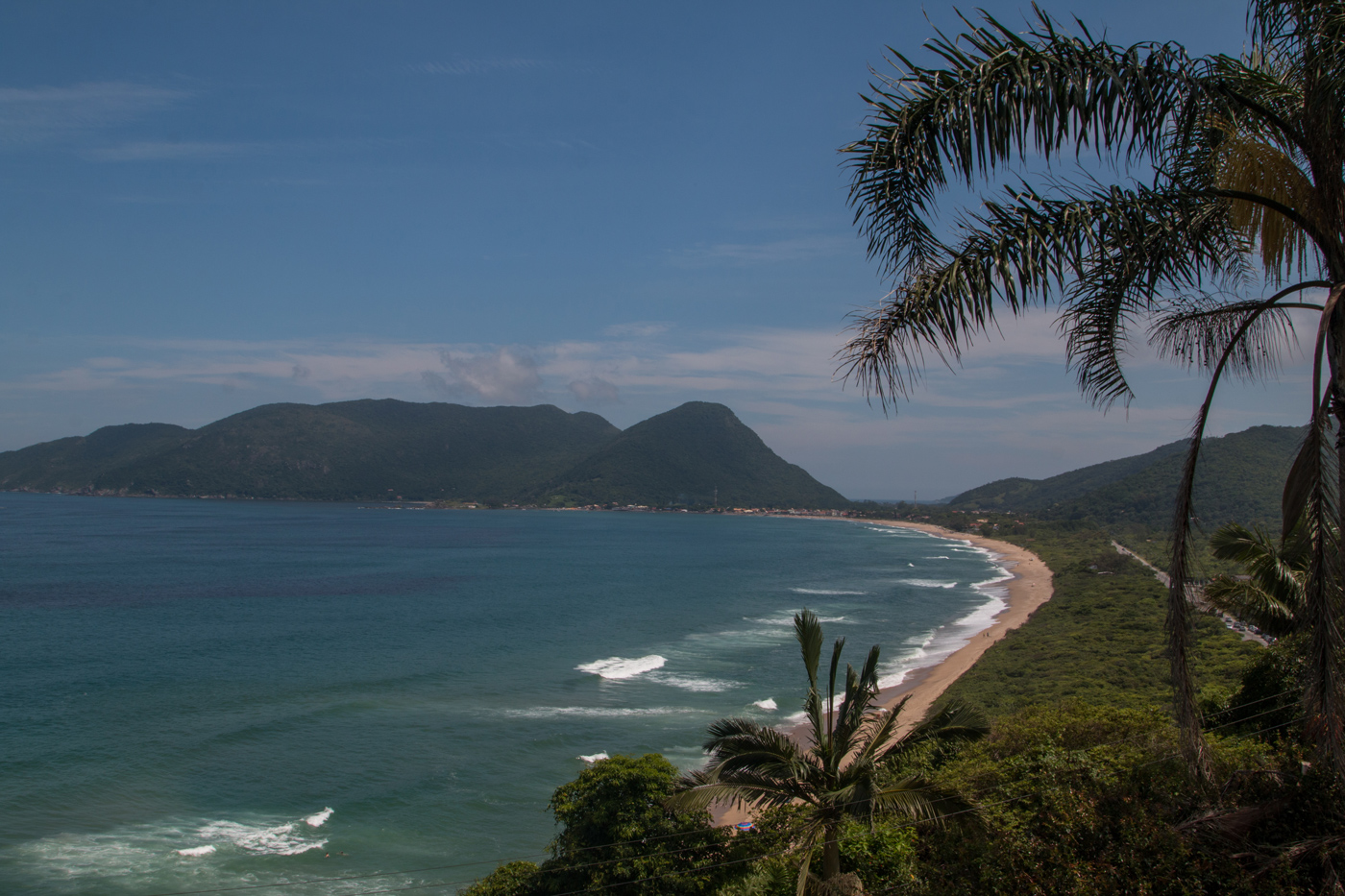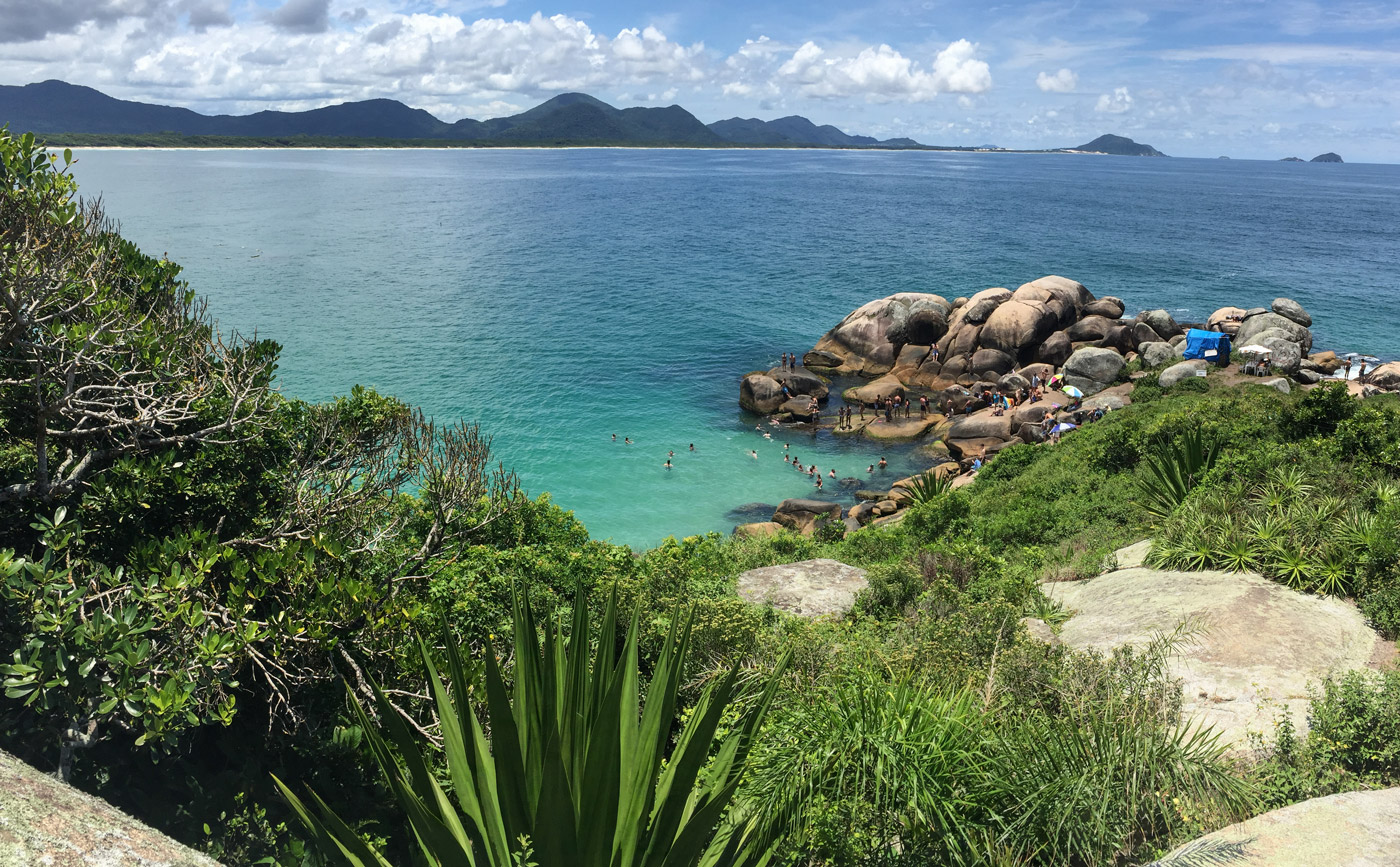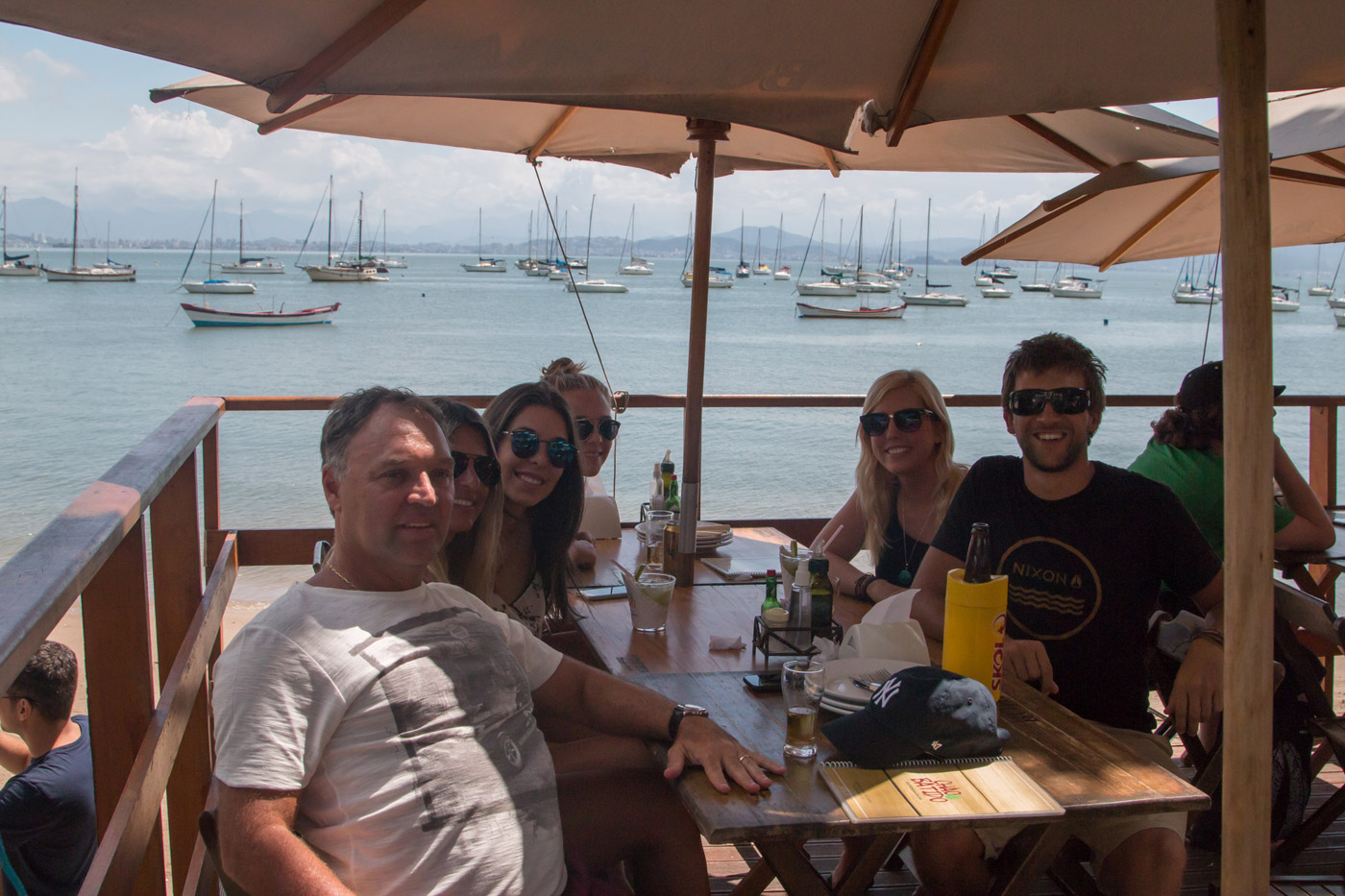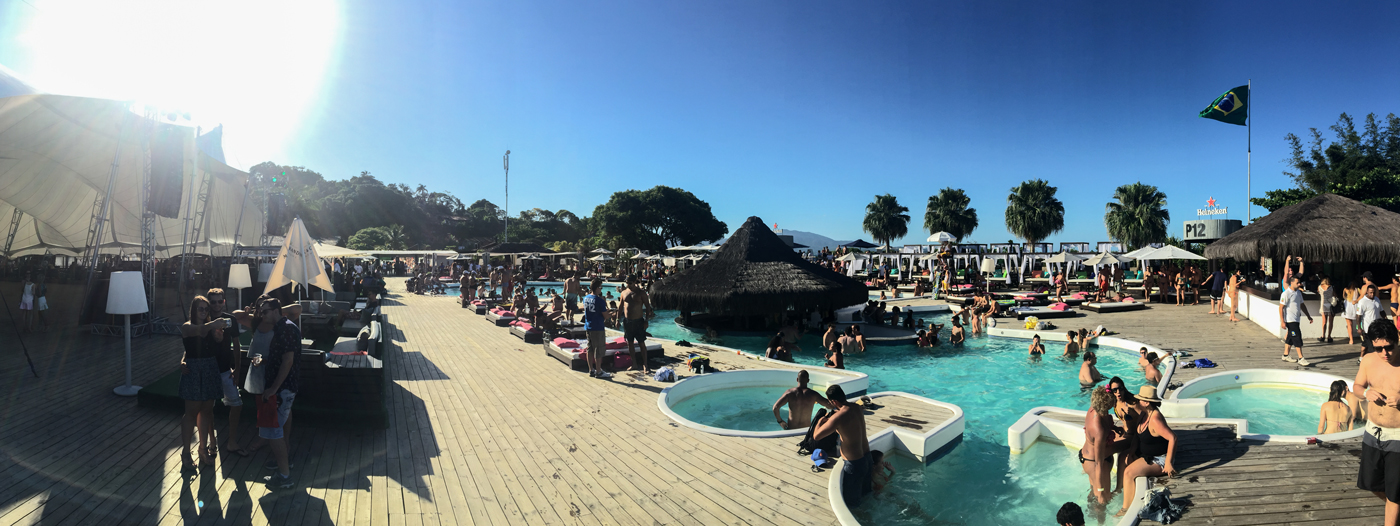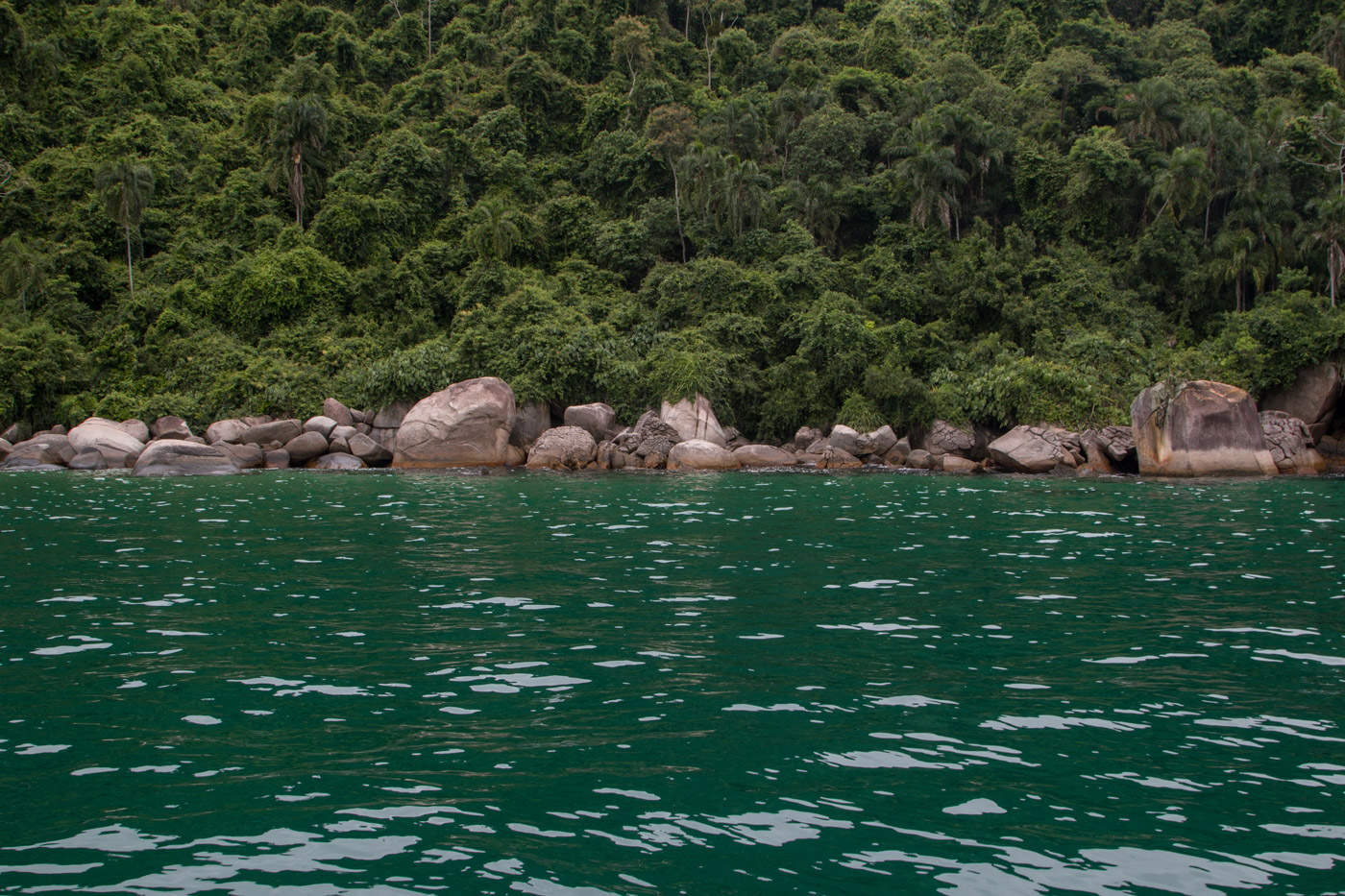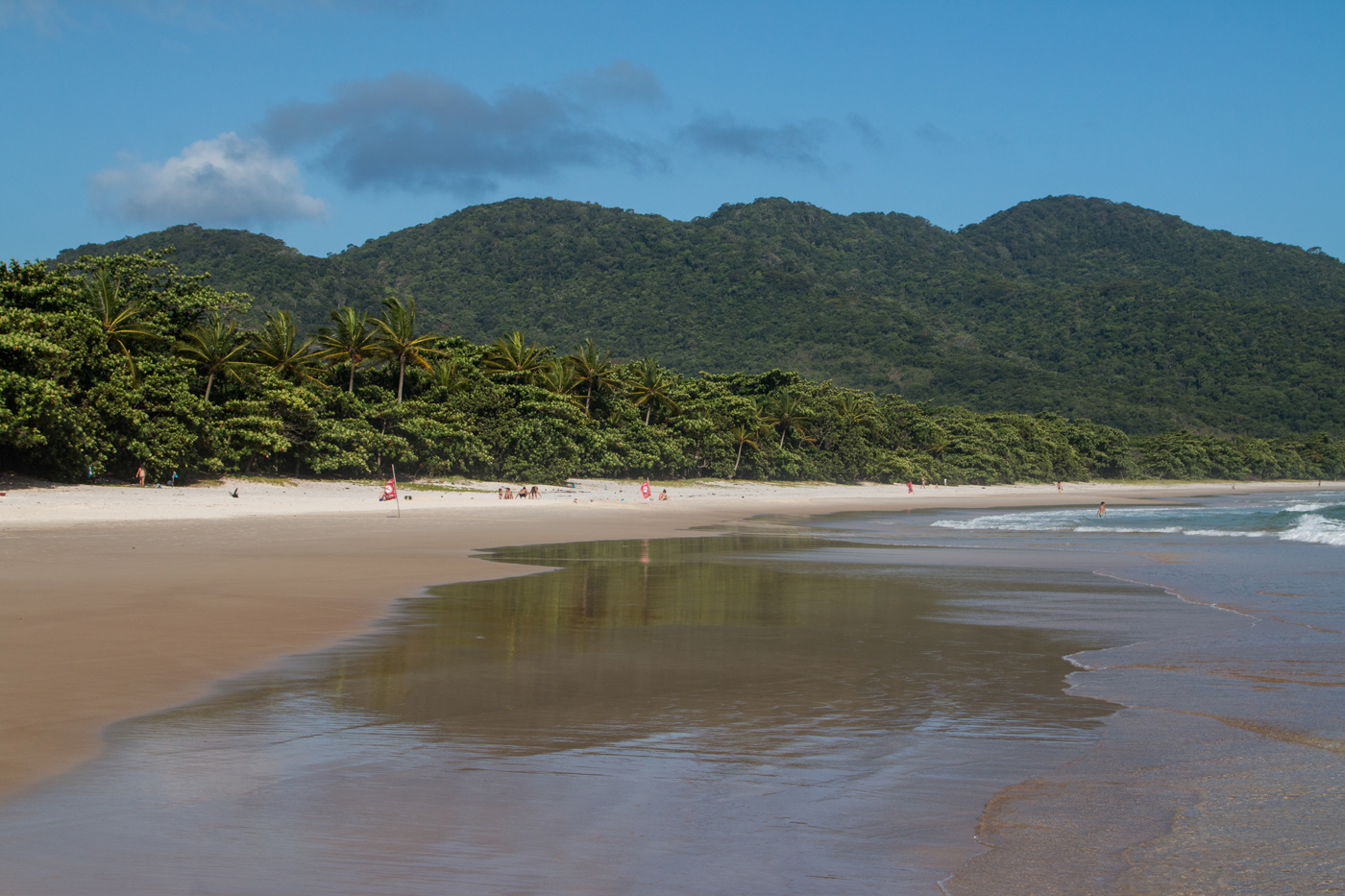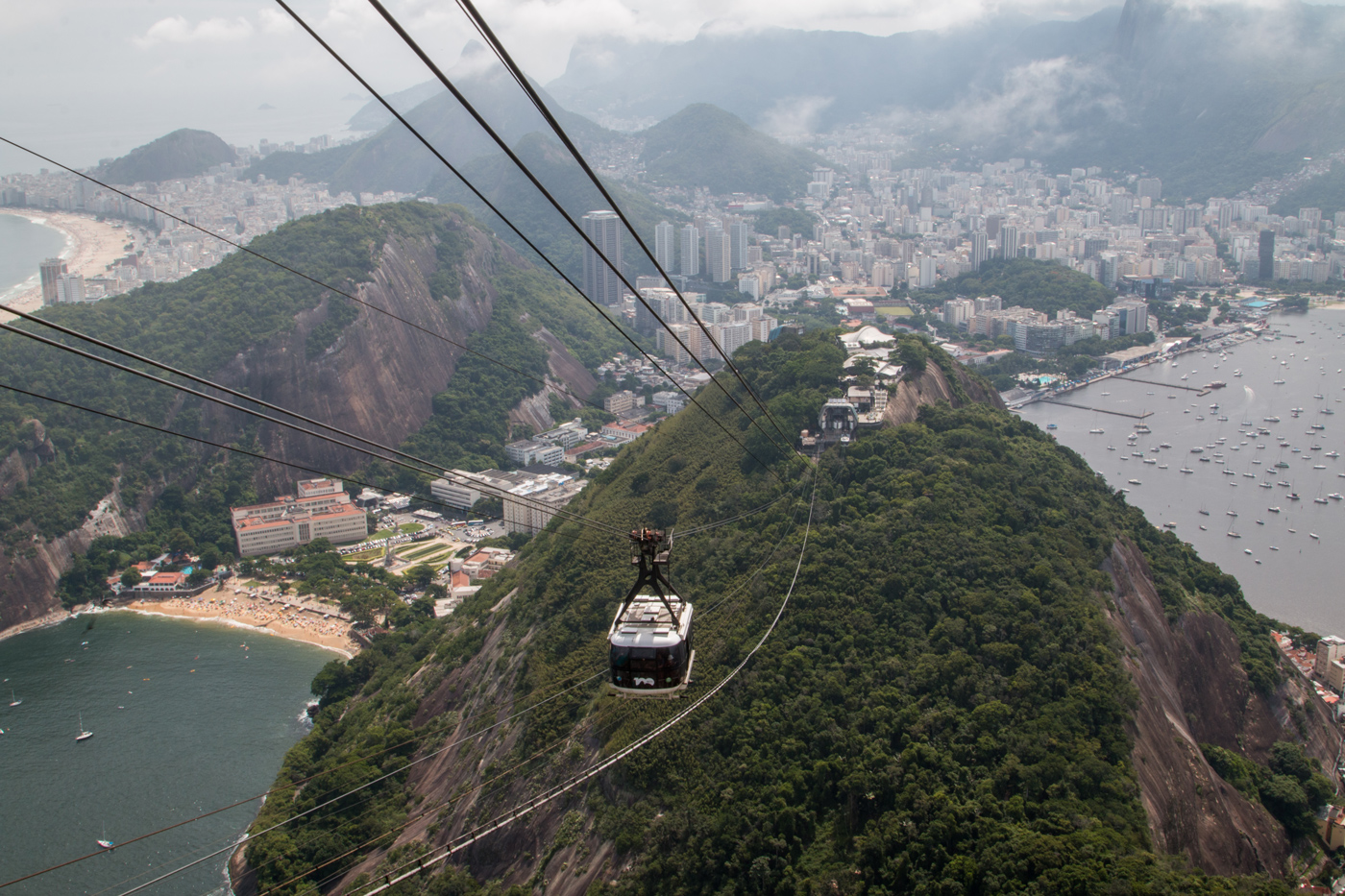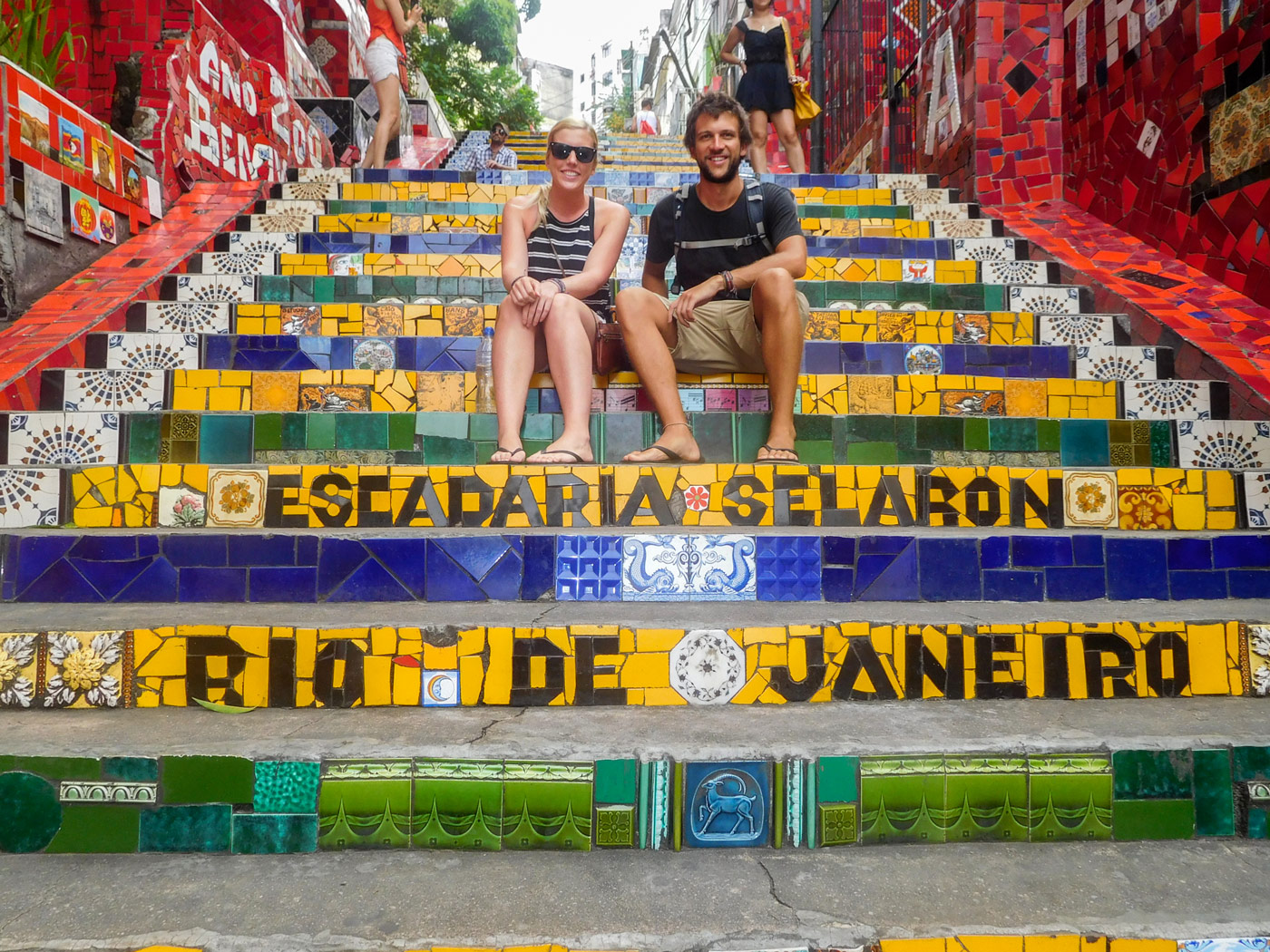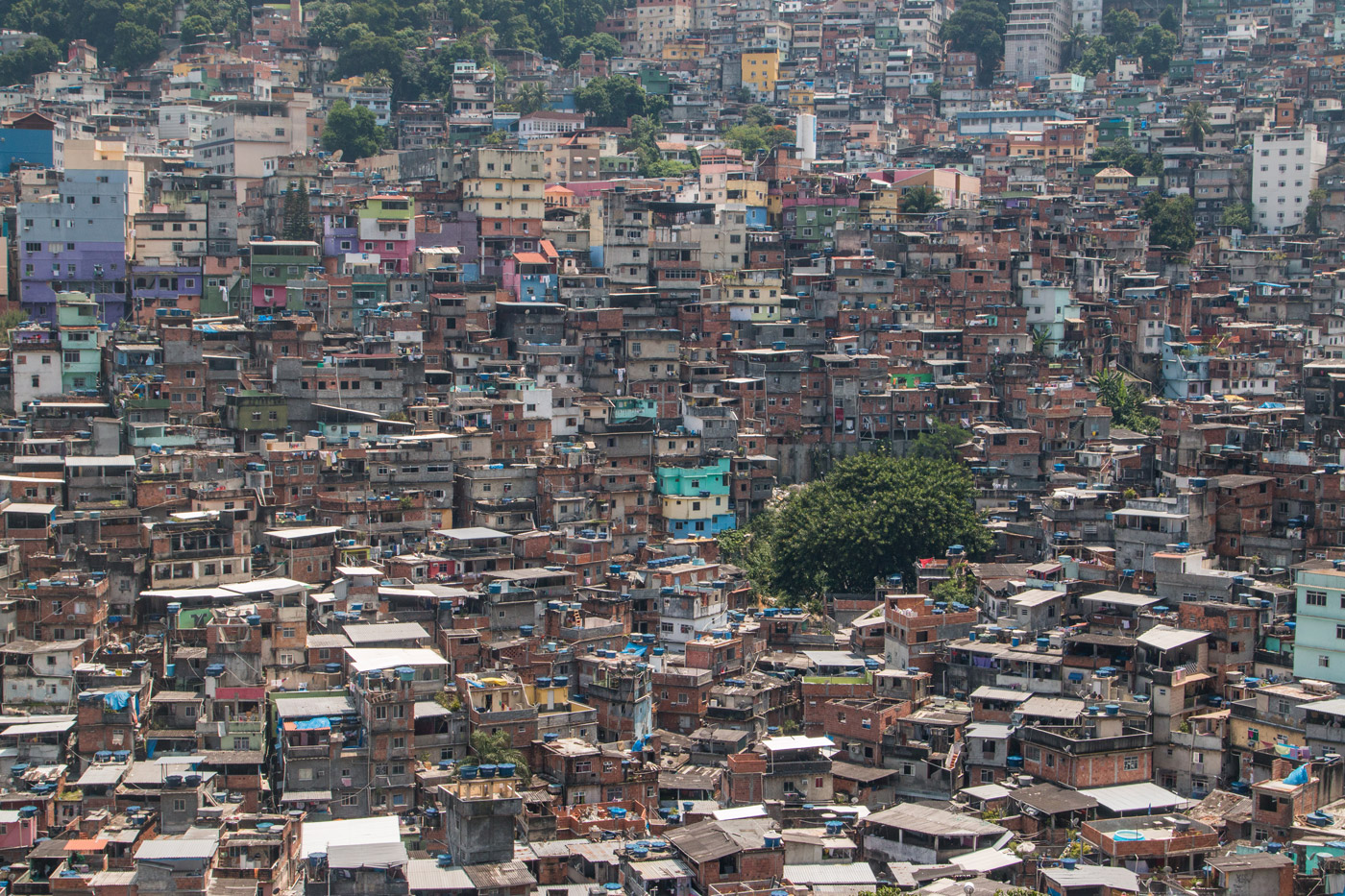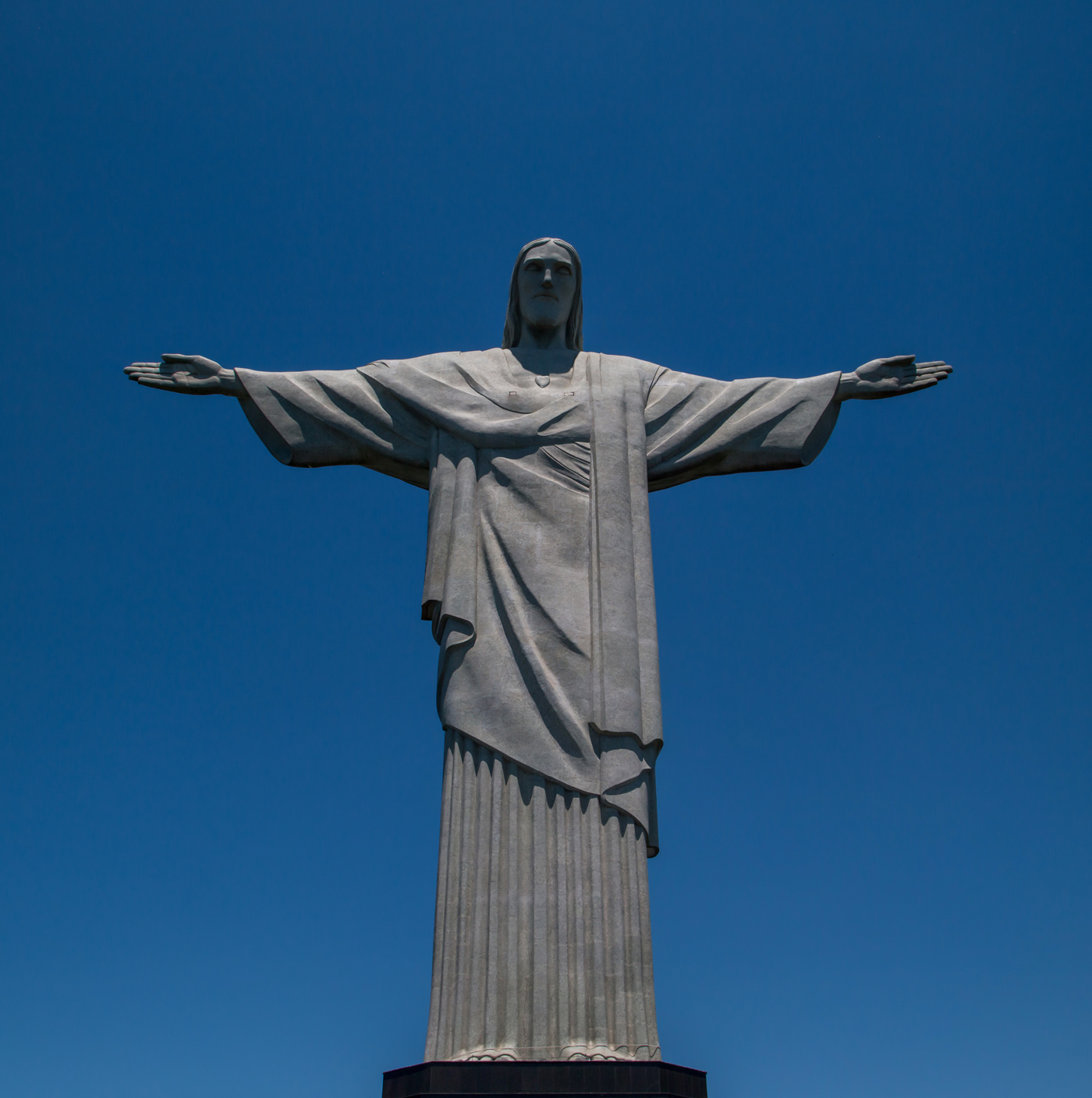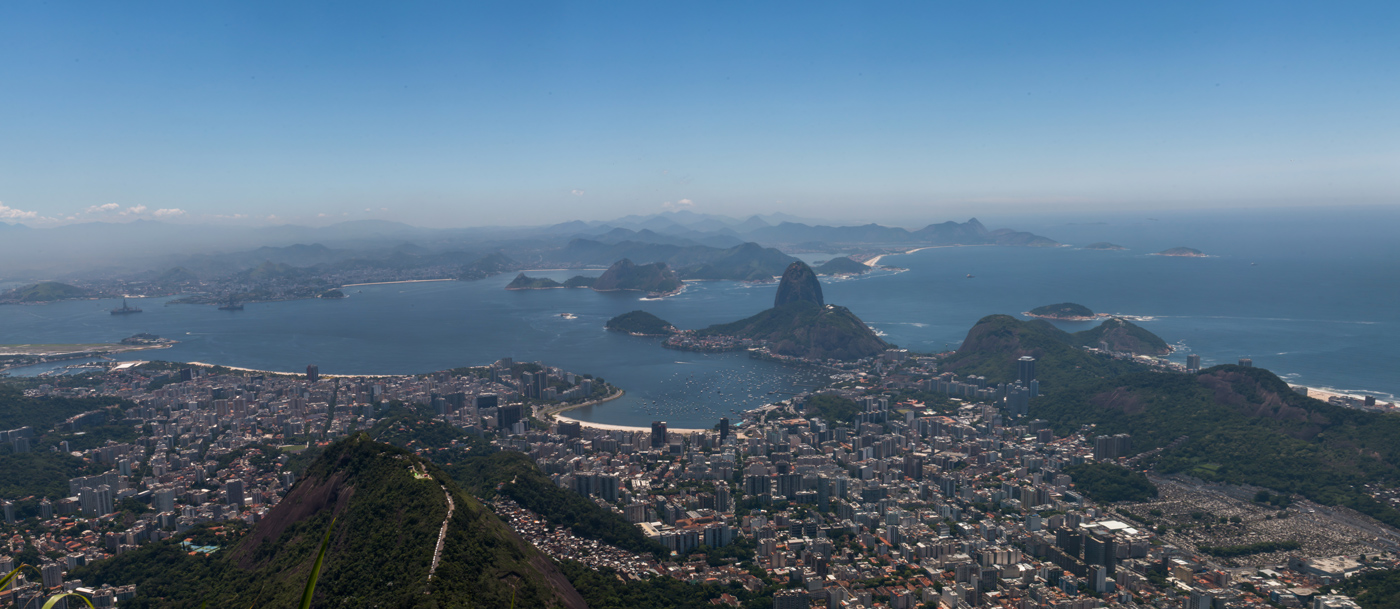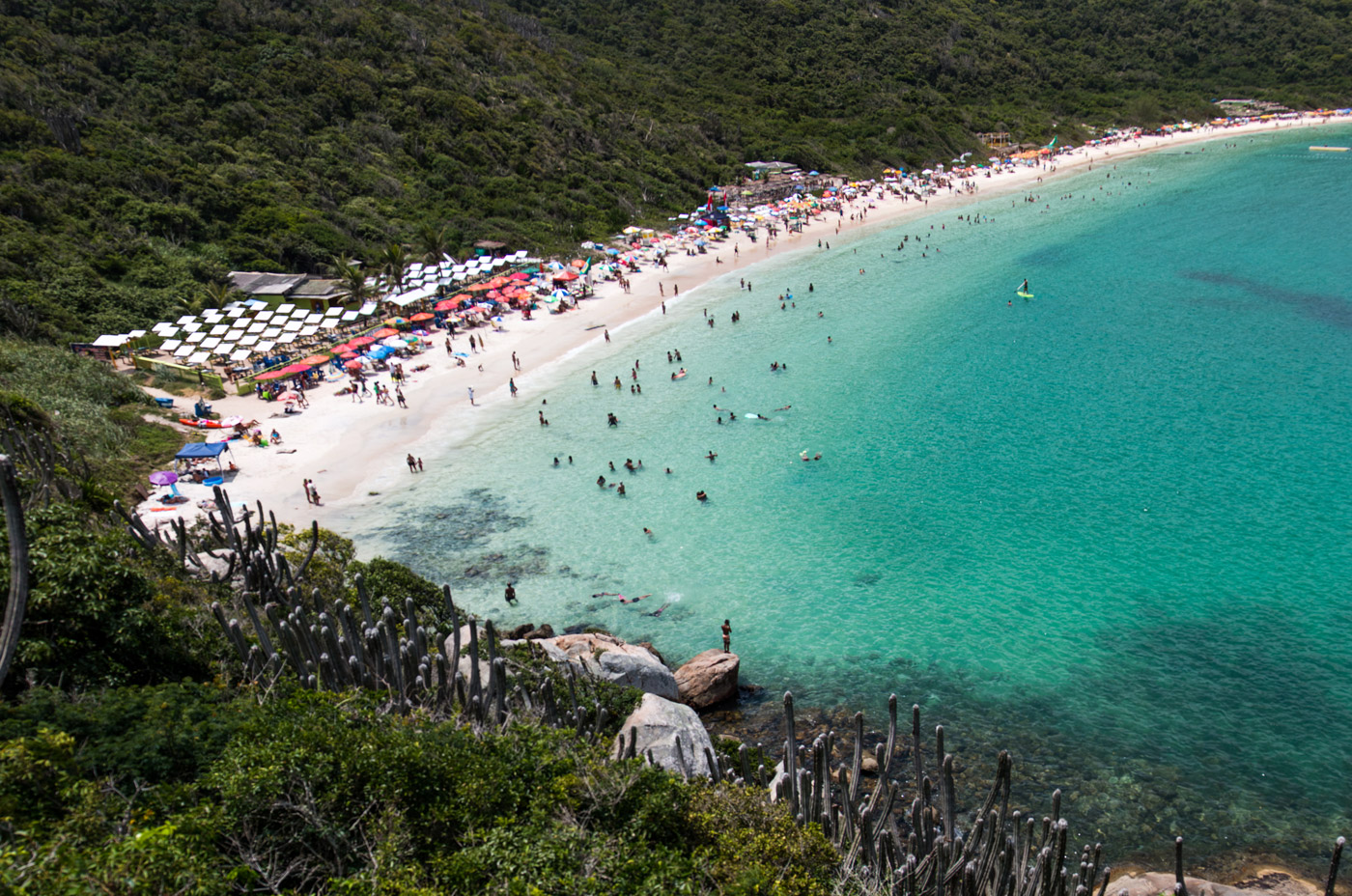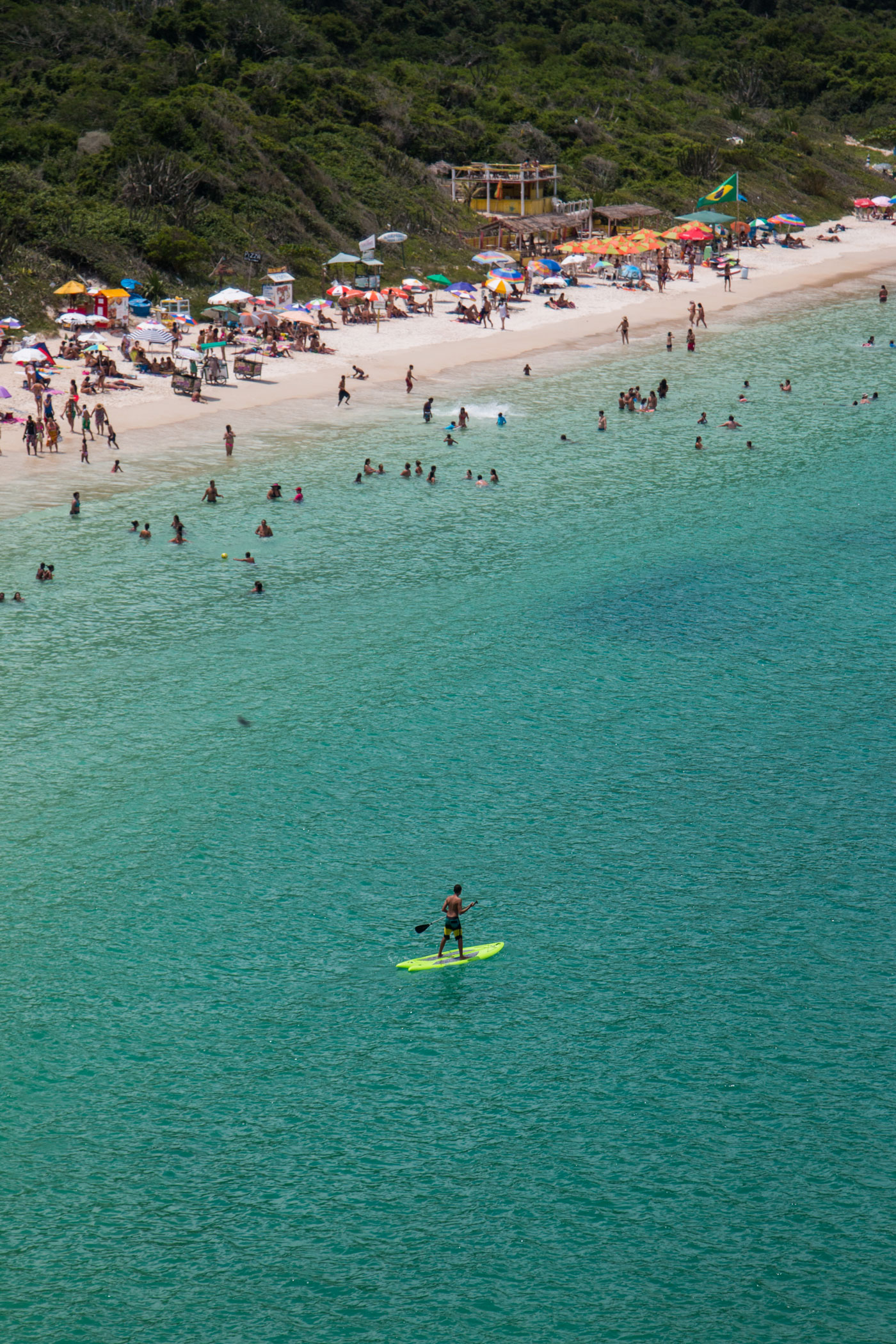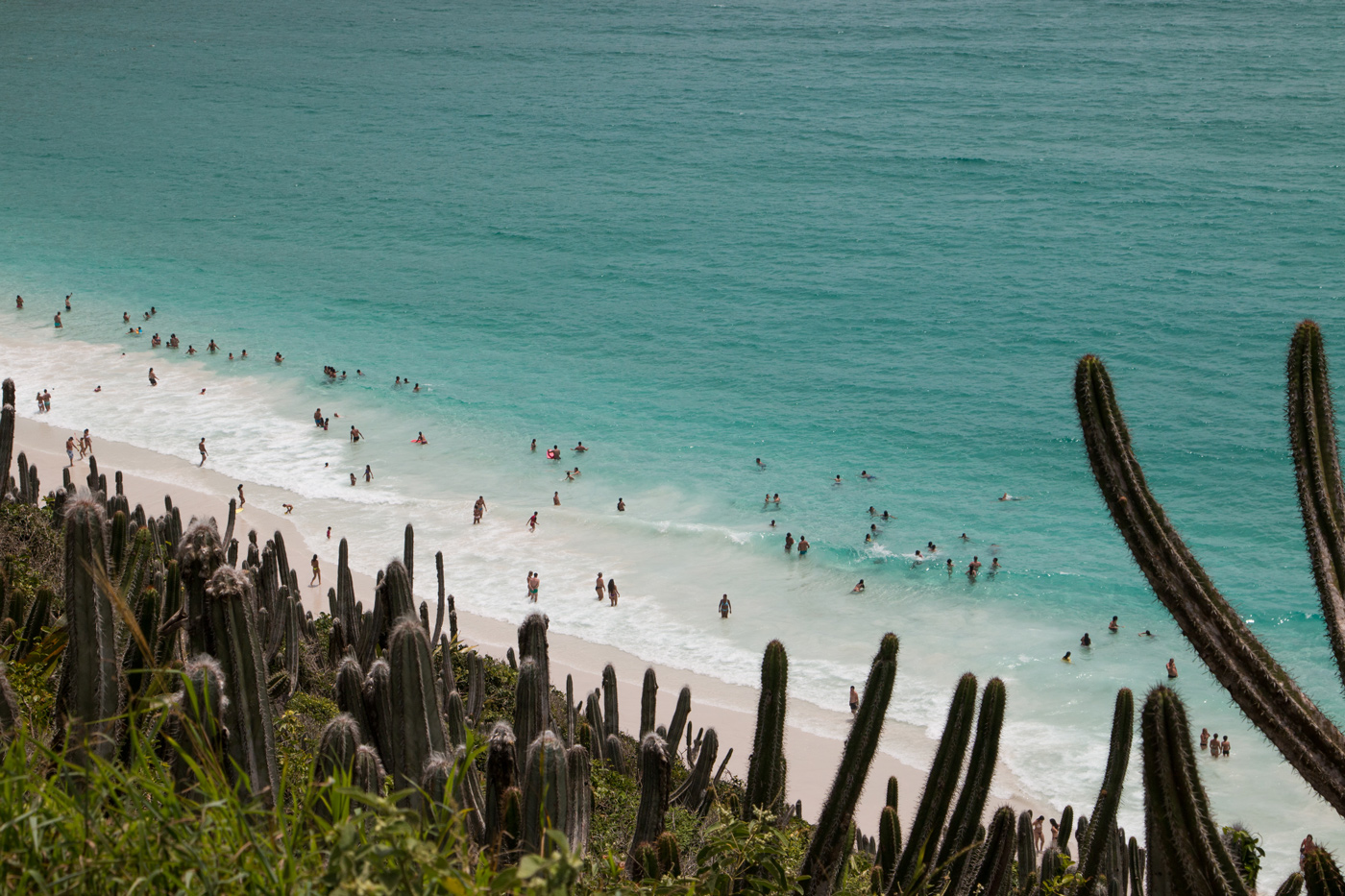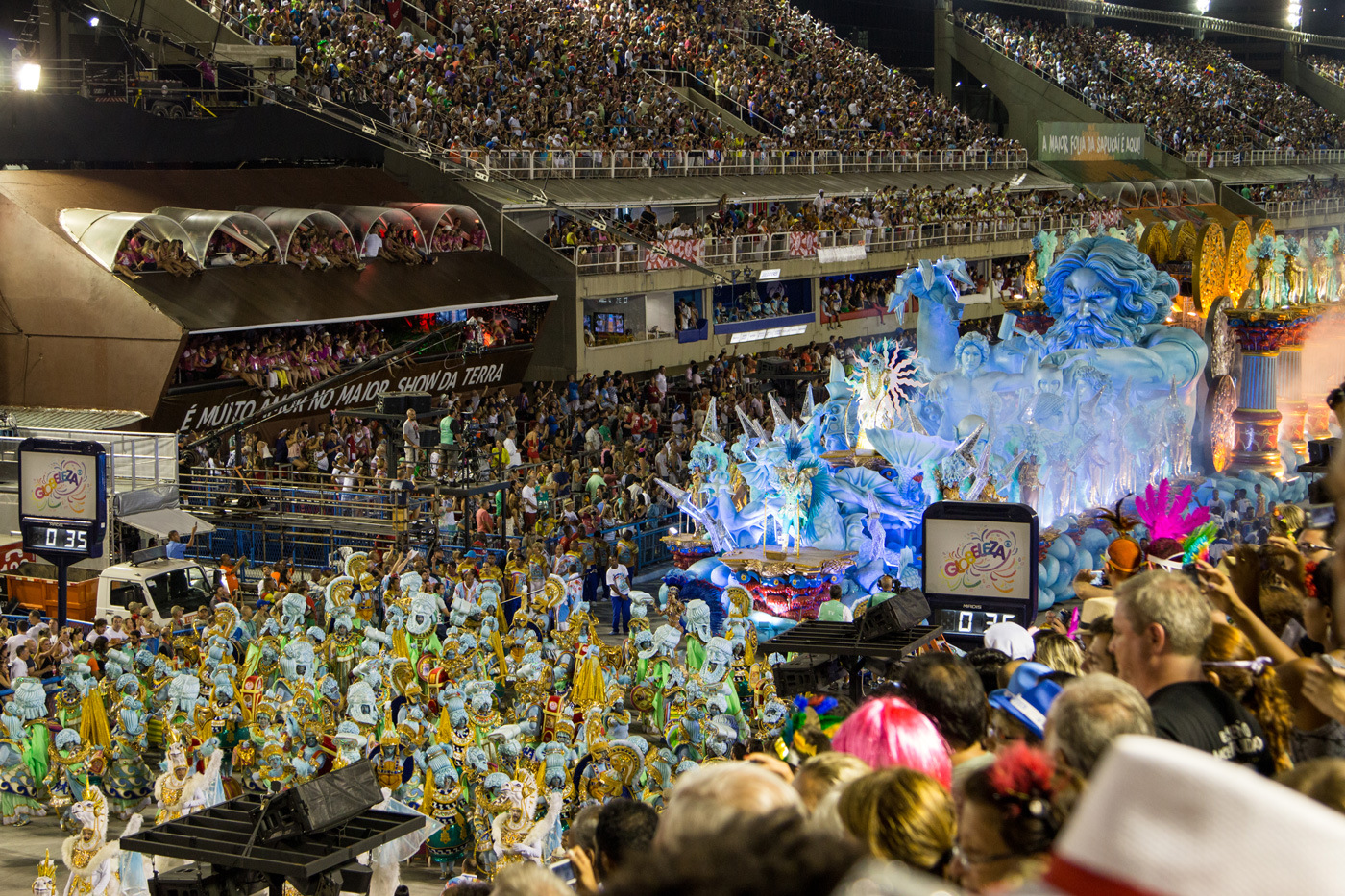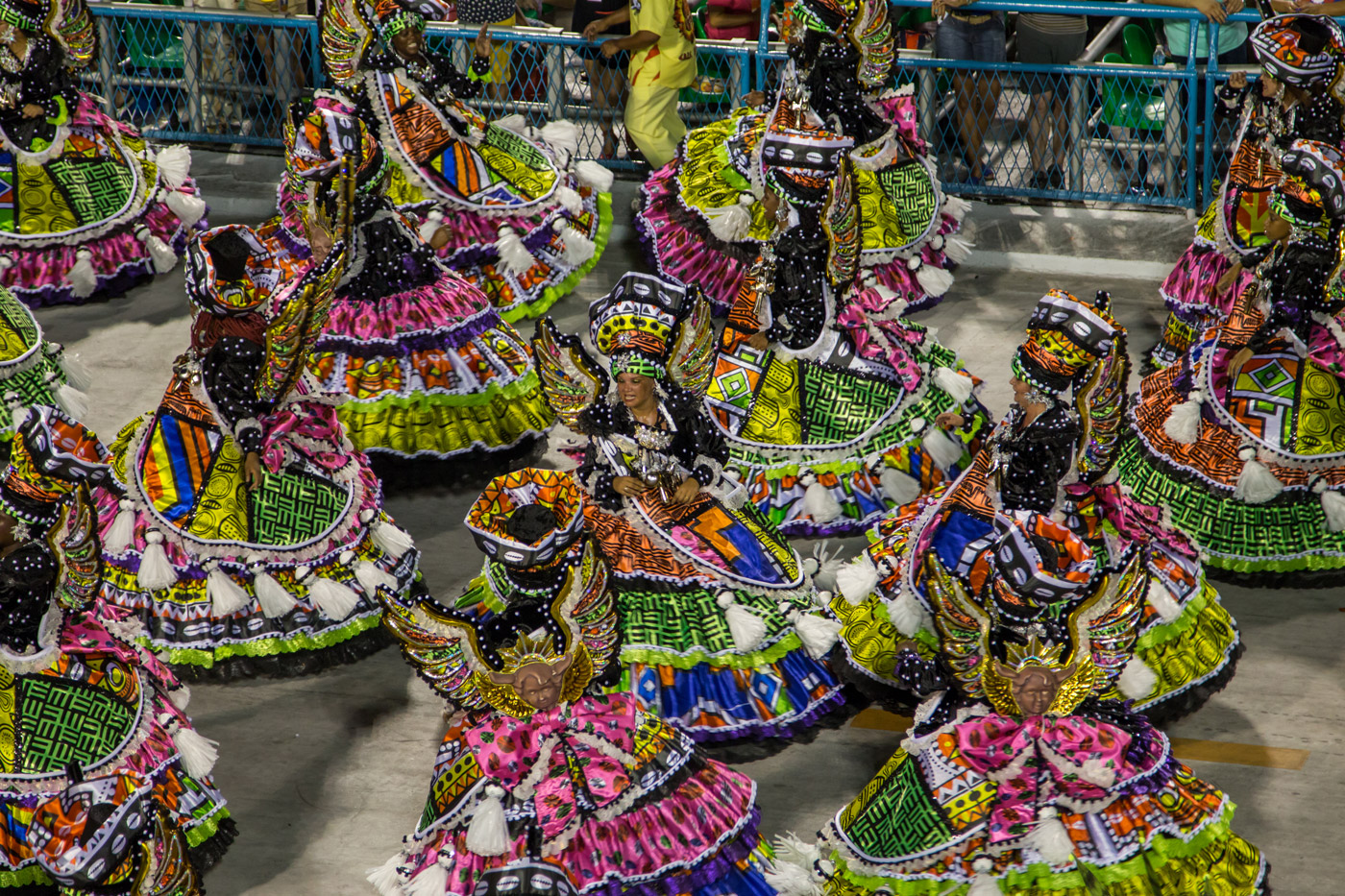Minutes after picking up our visas, we crossed the border leaving Argentina behind and found our way into Foz do Iguaçu, a town on the Brazilian side of the falls.
Immediately on entering Brazil and being confronted with the Portuguese language, we realised just how comfortable we had become with Spanish after spending the past nine months immersed in it. It had gotten to the point where we felt we could communicate well enough to get by, not only to order food, ask directions or buy bus tickets, but engage in basic conversation and even the occasional joke. Whilst we often couldn’t think fast enough or lacked confidence to reply in Spanish, it was both amazing and satisfying that, to our surprise, when it came to listening just how much we could understand. After months of fumbling our way through daily interactions and the occasional Spanish-only tour, we were finally getting it and could only imagine what it would be like to go back to the start of the trip knowing what we know now. We were shocked, perhaps naively, at just how different Portuguese is and it was unsettling, embarrassing and sometimes frustrating to find that we were back to square one, barely able to manage more than numbers, thank you and please.
The following morning we took a bus out to Iguaçu Falls to experience it from the Brazilian side. Situated in the middle of Iguaçu National Park the grounds are full of wildlife from butterflies, birds and tarantulas, to brazen coatis covering the paths and trying to get into people’s bags. This side of the falls were far less crowded, and though the paths didn’t lead out to the edge of Devils Throat like in Argentina, they still offered some amazing close-up views and allowed us to get staggeringly close and soaked from head to toe.
Florianópolis
Florianópolis, Floripa for short, is a large island in the state of Santa Catarina in southern Brazil known for its high quality of life and commonly regarded as one of the best places to live in Brazil away from the chaos of the big cities. The island is home to 42 beaches and as such is a very popular spot for surfing, stand-up paddleboarding, windsurfing and many other watersports.
We spent the first few days in Lagoa da Conceição, a small trendy town with many cafes, health food stores, food trucks and surf shops. Having spent over a month between inland Brazil, the huge city of Buenos Aires, and the cold mountains of Patagonia it was finally time to get the boardshorts back out and enjoy the beach.
We quickly learnt that Brazilians love the beach! Umbrellas covered every piece of the sand and were filled with families settled in for the day. We joined the rest of the population and lay on the beach for the first two days, visiting Joaquina and Praia Mole. People walked along the beaches selling everything from beer and cocktails, to food, coconuts, clothing and sunglasses and as expected, girls in tiny bikinis could be seen in every direction.
Whilst we loved the majority of the food throughout the trip, Brazil and especially Floripa, was definitely a highlight. It was hard to go wrong at meal time when fresh seafood was the local specialty. I’ve never eaten so many prawns in the space of a week. A sure favourite for the both of us, and one of the most traditional dishes served in Floripa, was the sequência de camarão (sequence of prawns). Ordering it twice in three days, the $30AUD meal for two consisted of plate after plate full of prawns cooked in all sorts of ways including breaded, barbecued, garlic, and a huge fish fillet covered in tomato prawns as well accompaniments like rice, chips and salad.
I had first heard of Florianópolis from a Brazilian friend back home. I used to work with Rodrigo and he would often tell me that if I ever went to Brazil I had to visit his hometown and so when we finally got our visas and entered Brazil I contacted him to let him know. Unbeknownst to us both Rodrigo and his wife Guta kindly put a post on Facebook reaching out to any friends and family that would be able to show us some Brazilian hospitality. We were overwhelmed by how many people seemingly dropped everything and kindly offered their time.
First up was Michel, along with his wife and son, who picked us up from our hostel early one morning and took us out for a whole day tour of the southern part of the island. Like many other young Brazilians we met, Michel’s son Pedro spoke English and was very helpful in translating whenever either side got stuck. After making our way south we parked the car and started the day with a 40 minute walk through the bush to one of Michel’s favourite spots, a near empty beach with clear blue water and bright green dense jungle all the way to the sand. It was far from the umbrella and salesman filled beaches of the days before and we enjoyed a refreshing swim and bodysurf watching dolphins pass by not far from the shore. Together we all walked along the beach and climbed up to a lighthouse for a panoramic view of the area down below. When lunchtime came around we had fresh fish sitting at tables in the sand in front of a small hut-like restaurant. Further to their generosity, Michel refused to accept any money for the meal and instead we walked back to the car to continue our drive around the island. We visited lookouts, beaches, small towns and finally the shop of their family friend where we enjoyed açaí bowls overlooking the lake. Lauren and I thoroughly enjoyed spending time with Michel and his family and were grateful to have a local be able to be show us the kind of places that we never would have known about, let alone been able to get to on our own.
Now staying in another neighbourhood, Barra da Lagoa, the next morning Lauren and I walked to the nearby natural pools. We laid in the sun and jumped from the rocks into the water to cool down. Looking back towards the beach covered in people the ocean rockpools were far quieter and more relaxing.
That afternoon after another sequência de camarão lunch at a restaurant overlooking the beach we were picked up by Rodrigo’s sister Andrea and her daughter Bianca. We had organised to spend a few days staying with their family in their beachside apartment in the north of Florianópolis. Bianca spoke fluent English, and her younger sister Leticia was also learning which was very helpful when we got stuck but before long the whole family was trying to learn, especially their dad Carlos who, despite his daughters constantly laughing at him, did impressively well. They also taught us some basic Portuguese and together we communicated fine.
By this stage I had been travelling for over a year and it was such a nice change from hostel life to be in a beautiful clean house, with our own bedroom and a clean bathroom and kitchen. The family all went out of their way to make us feel welcome from showing us their favourite spots around the area, taking us out for a fancy lunch on the waterfront, driving us to places we wanted to visit, introducing us to local foods like tapioca and brigadeiros and helping to organise our time in Rio for Carnival after we made a late decision to extend the trip. Living in a household full of girls I think Carlos was happy to have another guy in the house and was always keen to have a beer on the verandah whenever we had the chance. Showing a keen interest in our trip we brought up some of our travel videos on their TV, wary not to bore them with a modern day version of the old travel slideshow. Turns out they loved them and insisted we show more.
Whilst Floripa is a popular tourist destination for both Brazilians and foreigners alike, up in the northern part of the island two Australian’s still seemed to be a bit of a novelty. Everyone we met was so friendly and enthusiastic to talk to us, from people waiting with us in line for hotdogs, to the sushi restaurant where the chef came out to meet us and give us some free sushi when we finished our meal. Most people we met knew someone that had either been to or currently lives in Australia.
Lauren had read about a famous day club called P12 located right on the beach in Jurerê Internacional, a very wealthy suburb where the richest Brazilians including actors and soccer players have their summer beach houses. P12 hosts big pool parties every weekend and so that Saturday we got a lift from Andrea and went to check it out. The huge pool, bars, music and atmosphere rivalled that of Vegas along with a big dancefloor, VIP lounges and pricetags to match. We had great weather and drank in the pool for the majority of the day before watching the live concert of popular Brazilian artist Nando Reis.
On our final day in Floripa we took a bus down to Guarda do Embaú as recommended by Carlos and paid $1 to get a short boat ride across the river to the beach. The river mouth is popular with stand-up paddleboarders and the beach a popular surf spot. We found a spot on the sand and I went out for a swim with my camera in the big surf to try and get some better shots of the surfers from in the water. The lifeguards came along on jetskis to tell the swimmers around me to get back closer to shore but saw what I was up to and just smiled and gave me a thumbs up.
That evening, we sadly said goodbye to Andrea and her family, thanking our new friends repeatedly for all their help, generosity and hospitality during our stay. We shared Facebook details and gave Andrea a card and present, her response needed no translation.
"minha casa é sua casa (my house is your house)"
Paraty
The trip to Paraty via São Paulo ended up taking a slow and frequently interrupted 26 hours. The travel time was not helped by an ongoing Brazilian trend that once everyone was finally asleep to then stop the bus and get them off at 3am for a 45 minute restaurant break.
Paraty is a small coastal town surrounded by jungled mountains between Rio de Janeiro and São Paulo. Its colonial town centre has cobblestone streets and buildings dating back to the 17th and 18th century. Our first day in town was wet and gloomy and we did our best to explore whilst struggling over the rugged, slippery cobblestone and puddles. The following morning we had booked a trip around the bay and set off from the dock aboard a pirate ship style boat. We stopped at several small, tropical beaches including Praia da Lula and Agua Azul and despite the grey weather continuing to linger we still enjoyed ourselves and swam in the clean, clear water off the side of the boat.
With little sunshine forecast and a bed bug incident, which in all honesty I was surprised had taken that long, we left Paraty by bus continuing north.
Ihla Grande
Ihla Grande is an island located off the coast of the state of Rio de Janeiro that remains largely undeveloped, free of roads and not a single motorised vehicle. What was once a leper colony and later a high security prison, the island’s scenic landscape and unspoilt tropical beaches now make it a popular tourist destination.
Like clockwork, just as we boarded the speed boat it started to pour rain. The only seats left were at the very front and so we both huddled behind Lauren’s tiny umbrella with all our bags and battled the rain and wind for the 1 hour 15 minute trip across to the island.
Thankfully the sun came out just after we arrived and so we made our way to our hostel, checked in and returned to the dock to find a taxi boat to take us to a nearby beach. The boat dropped us in a quiet bay filled with clear, blue water and palm trees lining the shore. Walking in the direction of the driver’s pointing we found a track at the back of the sand and followed it through the dense bushland, across the island to Lopes Mendes, a beach on the southern side of the island.
The nightlife consisted of live music and dance performances by locals along the beachfront, while the usual transient hippies that we had found common in these sorts of places sold handmade jewellery and souvenirs. Unsurprisingly, we both became very familiar with the large dessert carts being pushed around town selling locally made cakes, slices, biscuits and other treats.
The next day we took off on a full day boat tour around the island, stopping to swim at popular spots such as Lagoa Azul (Blue lagoon), Lagoa Verde (Green lagoon), Praia de Amor (Love beach) and Praia Feiticeira (Witch beach).
Rio de Janeiro
We organised a boat back to the mainland and a van to take us up to Rio, first staying in the wealthy beach suburb of Ipanema for two nights. Keen to enjoy the sun we spent the first afternoon at the beach, renting an umbrella and beach chairs from one of the many vendors. Beaches in Brazil are unlike anything I had seen, there was of course the salesman walking up and down the beach that I had mentioned earlier, but also bars with food, cocktails and coconuts, sprinklers making wet sand paths between the road and the shore so that you didn’t burn your feet and fresh water showers pumped down to the stalls so that if you were their customer you could rinse off. There was even a generator powering a router sitting under its own umbrella to give that vendor’s customers beach wifi!
That night we went to a street party along the beachfront. With the street blocked off, thousands of young people gathered in the hot, humid weather. Everywhere you looked was someone with an eski selling super cheap, cold beers making it almost too easy to just buy them as you walked along. People also make a living in Brazil collecting cans so there was always someone encouraging you to finish your drink, buy a new one and give them the old can, not that I needed much encouragement. Making our way through the crowds we eventually reached the band and danced with them briefly until they were finished.
One of the must see spots in Rio is the iconic Sugarloaf Mountain (Pão de Açúcar), rising almost 400m straight out of water. After some difficultly locating the correct bus, we managed to find our way and spotted the entrance to the ticket office easily as it was the one with the massive line… Several hours later we finally got on to a cable car taking us up the first leg to the smaller of the two mountains and midway point to the summit. After a second cable car up to the very top we enjoyed an amazing 360º view of Rio, the beaches and Christ the Redeemer fading in and out of the mountain fog.
Moving on from Ipanema, we switched hostels to stay in nearby Copacabana and spent our first afternoon at the beach, swimming and sitting on the sand drinking beer and coconuts and reading until 8pm. As one of the most famous beaches in the world it was just as I had pictured, thousands of umbrellas, hot sun, tanned bodies, dramatic backdrops of big mountains and lots of interesting people watching. No matter the time of day, hundreds of soccerballs and volleyballs can be seen bouncing all along the 4km stretch of sand in makeshift games between people of all ages.
Already a big fan of Brazilian BBQ back home, going to a churrascaria in Brazil ranked higher on my to do list than Christ the Redeemer! In this style of restaurant, meat waiters continually bring large sword-like skewers of meats around to every table cutting pieces for any diner that would like some. My favourite kind also offers a red light, green light type service where you place a round card green side up if you’re wanting more meat, and the red side face up if for some crazy reason you don’t. After thoroughly researching the best recommended places in town, we found Fogo de Chão nearby. Immediately I knew we were in the right place when the table had a cow shaped meat menu to visually highlight the many different cuts of meat offered. And many cuts there were, with their chefs’ specialty consisting of grilling 15 different cuts of meat the way they did it in the southern gaúcho (cowboy) regions, fireside roasted. The restaurant itself was much fancier and more expensive than we had became used to this trip but this was to be more than a meal, it was an activity. The meat was amazing, and I developed a reputation as a reliable “yes” amongst the waiters long after Lauren had finished eating. Every time I thought about stopping one of my new found friends would bring out second, or third, helpings of one of the meats I had really liked and I had to keep going. Forget meat sweats, I was more like meat drunk and we left thoroughly satisfied and so disgustingly full that the rest of the night was a write-off.
Other than churrasco, one of the foods I was most looking forward to when visiting Brazil was açaí bowls (pronounced ah-sigh-ee), an extremely popular Brazilian dish from the Amazonian region made of frozen and mashed açaí fruit. Often regarded as a superfood, the berries are rich in antioxidants and packed full of health benefits. It is commonly served as a smoothie in a bowl or glass topped with granola, banana, strawberries and other fruits and eaten for breakfast or a snack throughout the day. I’d had açaí before both at home and in the US but as its exported all the way from Brazil it typically costs a small fortune and I was keen to try it direct from the source to see how it compares. As it turns out, locally you can get a huge bowl together with fruit and granola for $2-3AUD and as a result they became our daily cheap, filling, refreshing and healthy breakfasts.
Another world famous attraction in Rio is Lapa steps, also known as Selarón’s Staircase, a crazy and colourful tiled stairway that was the work of a Chilean artist Jorge Selarón. Starting in 1990, Selarón began renovating the old steps with a mix of colourful tiles creating what he called a “tribute to the Brazilian people”. There are 215 steps in total, covered in over 2000 tiles collected from 60+ countries around the world. The steps have featured in many famous magazines, newspapers, documentaries and commercials from National Geographic and Coca-Cola to Snoop Dogg’s music video ‘Beautiful’, as Lauren embarrassingly pointed out in the form of public singing.
Hundreds of favelas exist in Brazil with over 600 located in Rio de Janeiro alone. We both had an interest in seeing one of these infamous favelas and found a tour that would take us deep into Rocinha, the largest favela in Brazil. Rocinha is built on a steep hillside and our tour started with a van dropping us off all the way at the top so that we could make our way down on foot. A staggering 11 million Brazilians (around half of the entire Australian population) live in these slums or shanty towns with basic sanitation, plumbing and electricity at best.
Right near the top we climbed some stairs to a rooftop allowing us to really appreciate the sheer size and density of Rocinha. Following the maze of dark, narrow paths downhill we watched some guys play makeshift drums and learnt about the culture and communities that form in the favelas. As per their reputation, most favelas do have serious gang and drug related crime problems resulting in shoot-outs, drug trafficking and militia controlled areas. From what we heard Rocinha has been cleaned up significantly in recent years with police and military presence bringing government control to the area, though during the tour we still managed to openly see the occasional drug dealers as well as guns…
A trip to Rio would not be complete without visiting Christ the Redeemer, the iconic statue standing at the peak of Corcovado mountain overlooking the city of Rio and listed as one of the New Seven Wonders of the World. Waiting until we had a clear day, we braved the crowds and managed to work our way through to get some good photos and stop and admire the panoramic view down to both the city and ocean below.
With the midday sun beating down on us and the crowds of people testing our patience, we made our way back down to Copacabana and spent the rest of the day at the beach.
Arraial do Cabo
The end of our trip was sadly drawing near and with neither of us really ready to go home we made the decision to extend so that we could be in Rio for Carnival. After weighing up the costs, we decided it would be crazy to travel for this many months and go all the way to Brazil only to leave 10 days before the start of one of the biggest parties in the world.
We now had extra time to see a bit more of the country before the start of Carnival. Keen to relax on the beach, we decided to head up north for six days to Arraial do Cabo, a location we had discovered on Instagram of all places. We had been immediately drawn in by photo after photo of pristine beaches and clear blue water and were eager to see for ourselves if it really was as good as the photos made out.
Arraial do Cabo is a small fishing town, free from fancy hotels, chain restaurants and touristy flair and yet it had some of the best beaches we had seen the whole trip. As it turns out the photos we had seen didn’t even do the place justice. Less than 10 minutes walk from the centre of town was Praia do Forno, a beach with some of the clearest water I had ever swam in. We rented some beach chairs and an umbrella and lay by the water until late afternoon.
With the town surrounded by stunning beaches we decided the best way to see more of them was by boat and found a local company that had a trip going the following day. We awoke to perfect weather and made our way down to the dock to find our boat. The bright blue sky and sunshine meant the water looked incredible with the boat’s shadow clearly visible on the white sandy bottom below. Our boat moved about between beaches, dropping the anchor so we could jump off and swim to shore.
Búzios
Located on a peninsula, Búzios is a resort town and popular getaway from the city of Rio. Its 23 surrounding beaches offer everything from calm, gentle bays on the western side to open facing surf beaches on the east coast. Wanting to get out and explore the area we rented an old open air VW buggy for 24hours and sped around the quiet streets with the wind in our hair. With our new wheels giving us some freedom we used a cartoon style map as a guide and found lookouts, rockpools, quiet bays and beaches up and down both coasts.
The next day we joined our whole hostel on a big party boat, drinking and dancing as it made its way around a few of the quieter bays until sunset. We stopped several times so that everyone could jump off and swim as people on the beach looked on with both confusion and disgust at the loud boatload of drunk backpackers that had just disturbed their peace.
After a slow start the following morning, we checked out of the hostel and made our way to the bus stop for the 4 hour trip back down to Copacabana, “rested” and ready to celebrate.
Carnival
Carnival is a world famous, week-long festival taking place annually in the week leading up to the beginning of Lent. These wild celebrations occur in cities across the whole country with Rio not only the biggest but the benchmark, having 200 different Samba schools participating just in Rio.
Despite the last minute decision to stay longer for Carnival, we were very lucky and had booked a good hostel right in the middle of Copacabana. With over five million people flocking to Rio every year, the city and its accommodation prices, swell to meet the demand. The streets differed from when we had visited just a week earlier, now with vendors selling costumes, closed streets with banners and barricades, and a party vibe throughout.
As well as the main parades hundreds of “smaller” street parties took place across the city at all hours, every single day. One day had over 70 street parties scheduled alone. Our hostel was well run and had a whiteboard in the foyer that noted the best parties to choose on that day, what time they started and what street they were on. These parties, or “blocos” to the locals, were typically run by different samba schools and neighbourhoods with trucks and floats carrying their musicians and dancers leading the way for the huge crowds that followed along behind. Even the parties starting before 9am had thousands of people drinking and dancing just as much as if it was night-time. The crowds and atmosphere were unbelievable, though sometimes overwhelming, with the biggest street party we attended having over 20,000 sweaty people packed edge to edge and slowly moving down the street.
Unsurprisingly, we stood out amongst the crowds and often had friendly locals coming up to chat. One night during a street party, a group dancing inside the roped off area in front of the motorcade waved us in past security. As it turns out, the girl’s Dad was up on the truck and was running the parade. We drank and danced with them for the rest of the night until the parade finished and they invited us to the after party in a nearby park. They introduced us to more of their friends and we hung around in their big group late into the night practising our Portuguese and them their English and sharing bottles of rum around the circle. Wanting to be nice, when I next went up to buy another drink from one of the street vendors I bought a couple extra for the the guys I was talking to. It was only later, when one of them said “my mum bought me one of these earlier” that I confusingly asked “wait, how old are you???”. I was shocked when I discovered I had been buying a 15 year old drinks, though it did explain why he kept saying “Man, I love you, you’re cool as f**k”…
The next day after a hungover breakfast, we joined some girls from our hostel and backed up for another bloco, this time in the neighbourhood of Santa Teresa, high up in the hills above Copacabana. Getting off the train at the bottom of the hill, we found mototaxis waiting to give people a ride up and so the five of us reluctantly jumped on the back of motorbike each and took off up Santa Teresa’s famous winding, narrow streets. Our drivers took corners on the wrong side of the road, dodged and split oncoming cars and cut each other off as we each sat on the back and watched the pothole filled road race under our thongs and the wind blow through our hair on our helmet-free heads. There was a mix of surprise and laughter as each passenger turned up safely at the top and we all found the nearest eski and bought much needed drinks. We quickly found the parade and joined the enthusiastic crowd full of costumes, drums, dancers and people on stilts. After a few hours in the hot sun the parade was winding down and so we caught a taxi down to Ipanema to grab some dinner before heading to the next nearby evening street party.
On our last night in Rio, and sadly the last night of the whole trip, we had purchased tickets for the main event in Carnival, the world famous parade that showcases the local samba schools who have spent all year preparing and rehearsing for the competition. Each school’s parade runs for over an hour and is made up of over 3,000 costumed performers and musicians, together with at least six elaborate floats reaching up to 13 metres high and 60 metres long. The competition is a major economic and media event for Brazil, with tens of thousands of spectators in the sambadrome and live screenings to millions across South America.
We watched on for hours as each school made their way through the sambadrome, each one better than the last. When last years champion school finished their amazing performance Lauren excitedly turned to me and said:
"that performance alone was worth the extra $1000 to change my flight home!"
It was definitely a fitting way to finish the trip and farewell Brazil as we walked bleary eyed out of the sambadrome at 4:30am.
The end
Lauren and I were flying home separately and so with less than two hours sleep we had a teary eyed farewell on the footpath and I waved her goodbye as she left in a taxi to the airport. I had until 7pm before my flight out of Rio de Janeiro and made the most of my last day by swimming at Copacabana, sitting on the beach with a beer and finally eating my weight in food at another Brazilian BBQ ahead of a casual 53 hour marathon of a journey home flying Rio de Janeiro → Brasilia → Panama City → Los Angeles → Sydney.
Starting in Ireland back in December 2014 and then followed by Japan, USA, Central America and now South America, I had been in serious denial about coming home. Though after 13 months since my last day of work it was unfortunately time. Whilst I had definitely missed family and friends, and other little things from Australia I was still not ready to come home and really struggled to settle back into everyday life again.
Since returning home from travelling many people have asked me if I have now “got it out of my system”. If anything, after all the amazing people I met and stories I heard, the list has only got longer not shorter! Instead I’ll finish with the following quote:
"I haven't been everywhere, but it's on my list"
